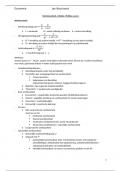Notas de lectura
8SM20 Biomaterials
- Grado
- Institución
Dit document bevat mijn aantekeningen van alle colleges die gegeven zijn in het vak Biomaterials, m.u.v. practice questions. Het is erg uitgebreid geschreven aangezien het tentamen open boek zal zijn.
[Mostrar más]








